 |
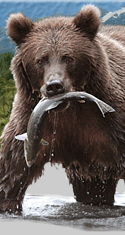 |
 |
||||||||
 |
 |
 |
 |
|||||||
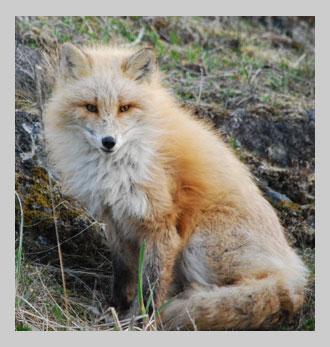
Text by Robin Barefield
Photos by Mike Munsey and Robin Barefield
|
The red fox (Vulpes vulpes) is a member of the Order Carnivora and the dog family Canidae. Red foxes occupy the largest geographic range of any member of the Carnivora, across the entire Northern hemisphere, Central America, and Asia.[1] The European red fox is the same species as the American red fox.[2] There are currently 45 recognized subspecies of Vulpes vulpes,[1] and while the classic image of a red fox may be a medium-sized canine with orange-red fur on its head, back, and sides; white fur on its chest and neck; black legs and feet; pointed black ears; and a long, bushy tail tipped in white,[3] the reality is that the 45 subspecies differ greatly in size and color. Only the white-tip on the tail distinguishes the red fox from other fox species.[2] To make the situation even murkier, red foxes have several different color morphs. The three most common are red, silver/black, and cross. Color variations are more common in colder regions.[1] |
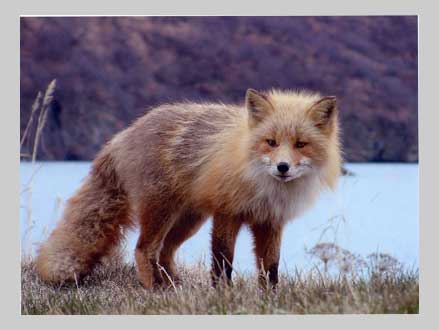 |
Red foxes are native to Kodiak Island, and the Kodiak red fox is a separate, distinct subspecies (Vulpes vulpes harrimani).[1] Members of this subspecies are very large in size with a huge tail, coarse, thick fur on the lower back and tail, and a thick ruff around the neck and shoulders, especially in the winter.[1] Most Kodiak red foxes are either cross foxes with a black/brown cross on the back and shoulders, or they are red in coloration. Silver foxes make up a smaller percentage of the population and are striking with black fur and silver-tipped guard hairs.[2] |
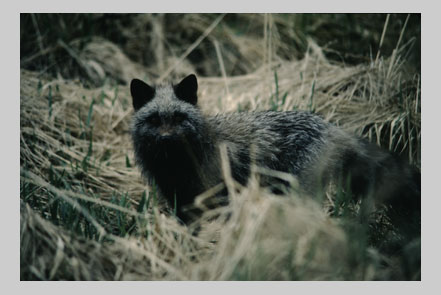 |
|
The red fox is the largest member of the true foxes.[1] It has a head and body length that measures approximately 22 - 32 inches (56-82 cm), relatively short limbs, and a fluffy tail that is approximately 14 - 16 inches (36-43 cm) long. Adults weigh between 6 and 15 lbs. (2.7-6.8 kg), but size and weight vary depending on the subspecies. [2] The front paws of a red fox have five digits while the back feet have only four.[1] Red foxes are capable of jumping over a 6 ft. (2 m) high fence, and they can run nearly 30 mph (48.28 km/h).[4] The red fox has extremely good hearing and unlike other mammals, can hear low-frequency sounds very well, allowing it to detect small animals digging underground so it can dig the prey out of the dirt or snow.[3] Although not as acute as its hearing, the red fox has a good sense of smell and binocular vision that reacts mainly to movement.[1] Anal and supra-caudal glands, as well as glands around the lips, jaws, and on the pads of the feet allow foxes to leave and detect scents that may mark a territory or a food cache.[1] Foxes use urine to mark their territories and food caches. A male raises one hind leg and sprays urine in front of him, while a female squats and sprays urine between her hind legs.[1] Red foxes are considered solitary, and they do not form packs like wolves.[4] They often do live in family groups, though, with a dominate male and female and often a few subordinate foxes all sharing the same home range. Subordinate females may help guard, feed and care for the kits.[1] |
|
Red foxes breed in February and March in Alaska.[2] Right after mating, the female makes one or more dens. The extra dens are used if the original is disturbed.[3] The den is a hole in the ground approximately 15 by 20 Ft. (4.57 m x 6.1 m) and may have several entrances. Foxes may dig their own dens, but they often just enlarge the homes of other small, burrowing animals.[4] Within the den, the female constructs a grass-lined nest where the babies are born.[2] The litter is born after a gestation period of 51 to 54 days. An average litter consists of four kits, although a litter of ten is not uncommon,[2] and litters of 13 kits have been reported.[1] Kits weigh about 4 ounces (113 grams) at birth.[2] They have fur but are blind, deaf, and toothless.[1] They are unable to thermoregulate when they are born, and the mother must remain with them at all times for the first two to three weeks. During this time, the father or barren vixens bring food to the mother.[1] If the mother dies before the kits are old enough to care for themselves, the father will take over as the primary provider.[1] |
 |
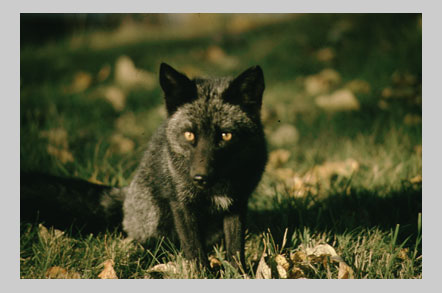 |
The kits' eyes open eight to ten days after birth, and they leave the den for the first time approximately a month later.[2] The mother begins weaning her kits by feeding them regurgitated food but then gradually brings them live prey to play with and eat.[3] By the time the kits are three months old, they are beginning to hunt on their own,[2] and they leave their mother when they are seven months old.[3] Red foxes usually only have one litter per year,[2] and except for a breeding female and her kits, the red fox normally does not use a den but sleeps curled up in the open with its bushy tail wrapped around its nose to stay warm.[3] |
|
In Alaska, voles appear to be the food of choice for foxes,[2] but the red fox is an omnivore and will eat fruits, berries, vegetation, insects, birds, rabbits, squirrels, and other small mammals.[3] On Kodiak, it is common to see foxes on the beach feeding on sea urchins and other invertebrates and digging for worms. Red foxes are considered nocturnal or crepuscular (active at dawn and dusk),[4] but they may be active at any time of the day, and on Kodiak, they are often most visible on the beaches during the morning and evening low tides. When hunting a vole, a fox locates the vole by sound and then jumps in the air and lands on its target much like a cat does.[1] An adult red fox will eat between one and two pounds (.5 to 1.0 kgs.) a day. |
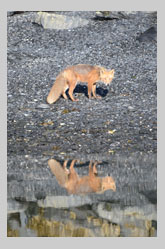 |
|
Like dogs, foxes communicate with each other through body language. Most body posturing is either aggressive/dominant or fearful/submissive.[1] A curious fox will rotate his ears while sniffing. When playing, a fox may perk up his ears and rise on his hind legs. When afraid, red foxes grin in submission, arch their backs, curve their bodies, crouch their legs, point their ears backward and pressed against their skulls, and swing their tails back and forth.[1] Submissive foxes maintain a lower posture when approaching a dominant fox. When two evenly- matched foxes square off, they approach each other sideways and display postures that suggest a mixture of fear and aggression, with ears pulled back, lashing tails, and arched backs.[1] When attacking each other, red foxes approach their opponents head-on instead of sideways. They hold their tails aloft and rotate their ears to the sides.[1] |
 |
In addition to body language, red foxes use vocalization to communicate with each other.[4] They have a wide vocal range and produce sounds spanning five octaves.[1] Biologists have divided the majority of the sounds into contact calls and interaction calls. Contact calls are used when two foxes approach each other or when adults greet their kits. Interaction calls are used either during courting, when dominant and submissive foxes interact, or during an aggressive encounter.[1] Another call that does not fit into either of these categories is a long, monosyllabic "waaaaah" sound that is made during the mating season and is thought to be a female calling for males.[1] Red foxes in the wild live about five years, although in captivity, they may live as long as fifteen years.[1] The red fox has several natural enemies, including man, wolves, coyotes, lynx, wolverines, and possibly bears. Eagles may prey on young foxes.[2] In some areas, an outbreak of rabies can kill large numbers of foxes,[2] but there has never been a reported rabies oubreak on Kodiak. The mite Sarcoptes scabiei causes mange in red foxes, which results in hair loss, wasting and death. Foxes are also susceptible to infestation by a variety of other parasites.[1] |
|
The red fox has been the subject of songs, fables and parables.[1] In certain areas, foxes are trapped or shot for their furs, and in the early 1900's, fox farms were established on many small islands around the Kodiak Archipelago and off the Alaska Peninsula for the purpose of supplying pelts.[5] Most red fox populations are considered stable.[4] Red foxes are very adaptable animals, and while they seem to prefer a wild setting, they are able to thrive, even when living in close contact with humans.[2] |
 |
|
Literature Cited 1. Red Fox. Available at: en.wikipedia.org/wiki/Red_fox 2. Jennings, Larry. 2008. Red Fox. Alaska Department of Fish and Game. Available at: www.adfg.alaska.gov/static/education/wns/red_fox.pdf 3. Red Fox Vulpes vulpes. NatureWorks. Available at: www.nhptv.org/natureworks/redfox.htm 4. Red Fox. The Alaska Zoo. Available at: www.alaskazoo.org/red-fox 5. Culture and History: Kodiak Island.net Internet Directory. Kodiak Island.net. Available at: www.kodiakisland.net/cultureandhistory.php |
Copyright 2012 Munsey's Bear Camp